This week’s #BeConnected Explore Our Campus looks at the collection of paintings of Scottish colourist J D Fergusson (1874-1961) in the Art Collection.
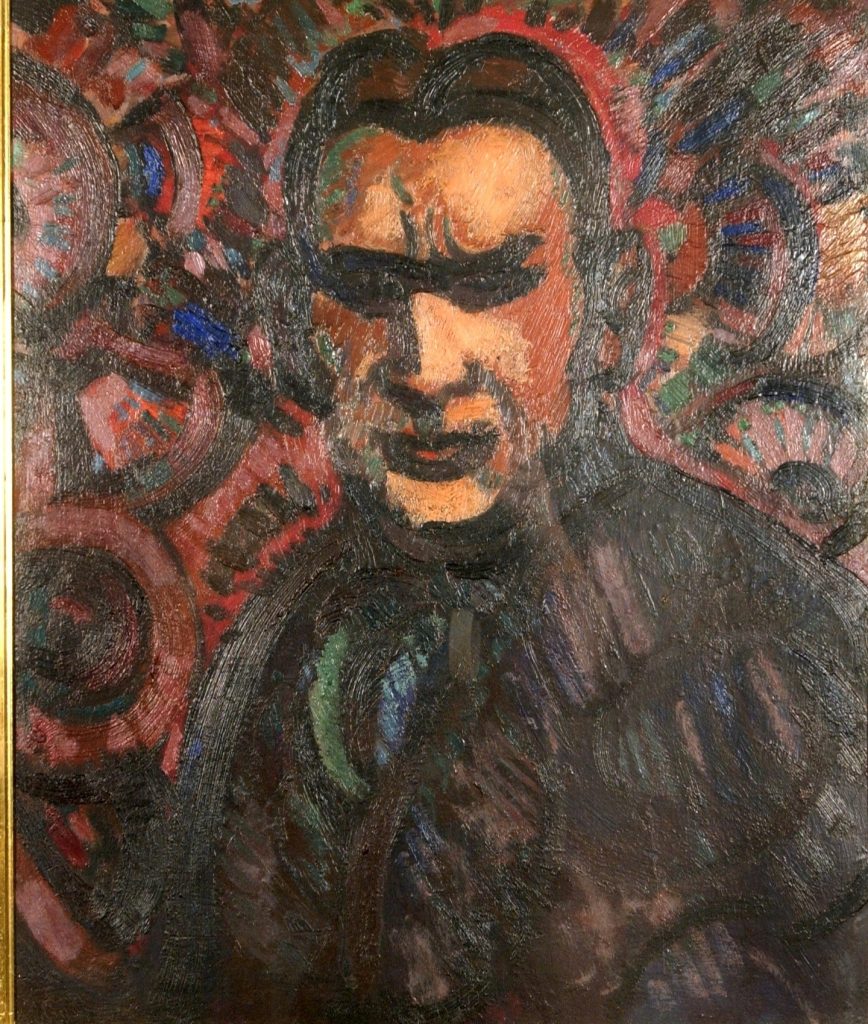
(OIl on board, 1907)
In 1968 the brand new University of Stirling was fortunate to be presented with a collection of 14 paintings by the eminent Scottish painter John Duncan Fergusson. The ‘J D Fergusson Memorial Collection’ was gifted by the artist’s widow Margaret Morris, as a mark of her friendship with Tom Cottrell, the University’s first Principal, and her excitement at the inauguration of a great new adventure in Scottish education.
J D Fergusson was a principal artist in the group now known as the Scottish Colourists, which combined French Impressionist techniques with Scottish themes to produce outstanding works in the early 20th Century. The collection of fourteen of Fergusson’s paintings at Stirling was chosen to represent all periods of his life from his very early Bazaar in Tangiers (c. 1897) to A Bridge on the Kelvin (1942). It contains some of his finest work and includes the seminal painting Rhythm (1911). This blog post focusses on just some of these works. They can be viewed in full here.

(Oil on canvas, 1897)
The first of four children, J D Fergusson was born in Leith in 1874. After the Royal High School, the idea of being a naval surgeon appealed briefly, but Fergusson soon realised that his vocation was to paint. Art studies in Edinburgh became too rigid for him however and, resolving to teach himself, he started to travel. Around 1897 he went to Southern Spain and Morocco. In his works of this time he acknowledged the influence of Arthur Melville who had made similar painting excursions ten years earlier. As can be seen above in ‘Bazaar in Tangiers’, his oil paintings of this time are loosely worked, with a restrained palette.
He started to spend time in France, meeting fellow artists and studying at the Louvre, deeply impressed by the Impressionist paintings in the Salle Caillebotte. During these years the strongest influence on Fergusson was his friend S J Peploe whom he had met in the late 1890s.
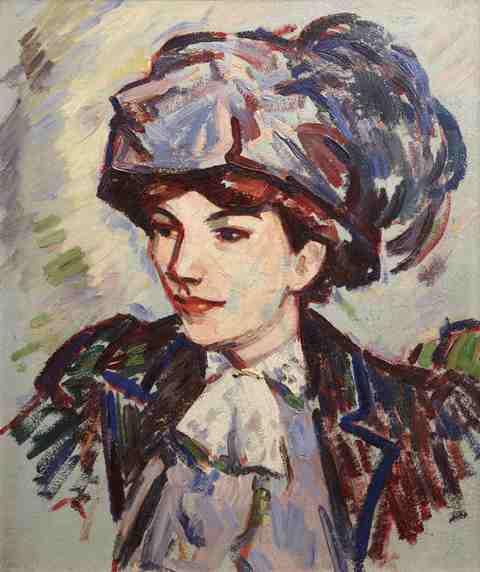
(Oil on canvas, 1910)
In 1907 Fergusson moved to Paris and began to fully embrace the new era. During the first years of the new century, the city was a ferment of ideas in art, literature, philosophy, music and dance. Here, he was a contemporary of Picasso and was influenced by such artists as Cezanne, Monet and Matisse and the intense colour of the Fauvists such as Derain. This painting deploys fauvist use of colour to delineate form, and gains energy from the unpainted areas of canvas and the set of the shoulder axis.
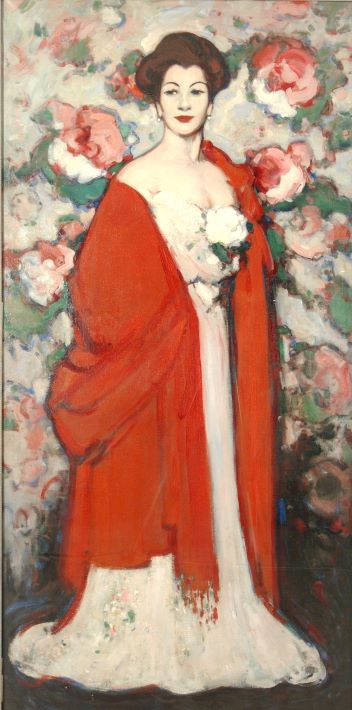
(Oil on canvas, 1908)
He also painted the many friends he made during this time. In this portrait of the American writer and critic Elizabeth Dryden, colour is used descriptively on form, whilst the background is a decorative surface of diminuished perspectival depth. This painting was exhibited in the Paris Salon d’Automne in 1909.
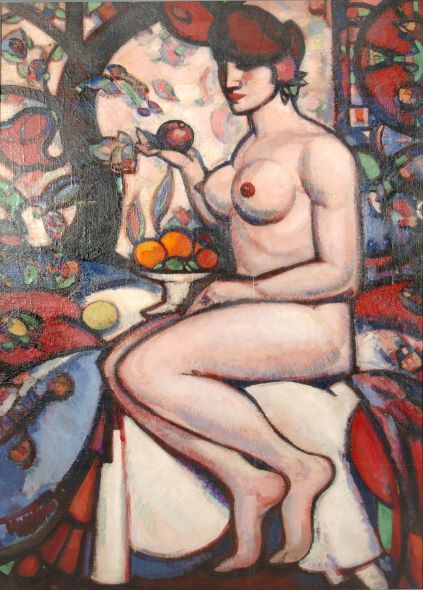
(Oil on canvas, 1911)
‘Rhythm’ was a key modernist concept, based on the philosophy of Henri Bergson, and this painting is perhaps Fergusson’s first modernist masterpiece. The young John Middleton Murry met Fergusson in 1910 and remembered ‘one word in all our strange discussions – the word ‘rhythm’. We never made any attempt to define it….for F. it was the essential quality in a painting or a sculpture; and since it was at that moment that the Russian Ballet first came to Western Europe….dancing was obviously linked, by rhythm, with the plastic arts’. Middleton Murry subsequently founded a literary magazine with Rhythm as the title, and Fergusson became art editor – a design based on this painting was used as the cover design. The painting itself shows a proud healthy Eve-like woman, complete with apple, though she seems more self-assertive than alluring or guilty. The figure is static but dynamic, poised to leap. Tension is introduced by the juxtaposition of verticals with more fluid lines, and movement through the shape and colour of her body and of the tree and drapes which surround her. Rhythm was first exhibited in Paris, at the Salon d’Automne, in 1911.

(Oil on canvas, 1918)
In 1914, with the outbreak of the First World War, Fergusson returned to live in London. This is one of a series of paintings which portray life in the naval dockyard at Portsmouth. The painting shows a dramatic viewpoint with strong verticals and a large destroyer’s bow. Energy not war creates the focal point. It was clearly influenced by the Vorticist movement. It has been claimed in the past that Fergusson was an official war artist, but apparently this was not the case. He was merely given permission by the Admiralty to visit the docks ‘to gather impressions for painting a picture’.
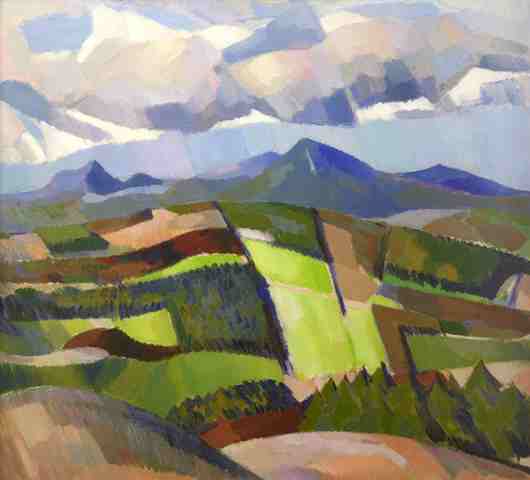
(Oil on canvas, 1923)
Painted after a tour of the Scottish Highlands in 1922, this picture illustrates a debt to Paul Cezanne and in its architectural approach to landscape heralds a new maturity in Fergusson’s art. It is a good example of a dialogue between colours and planes, created at a time when the artist was concerned with the problems of development of a shape within the many shapes of a composition. Many of the paintings from this trip were shown at his first major Scottish Exhibitions at the Scottish Gallery, Edinburgh and at Alexander Reid’s Gallery in Glasgow.

(Oil on canvas, 1937)
After the war ended, Fergusson began to visit France regularly again, settling with Margaret Morris in the south in the late Twenties. The colour and subject matter that he found there informed his painting and sculpture for the rest of his career.
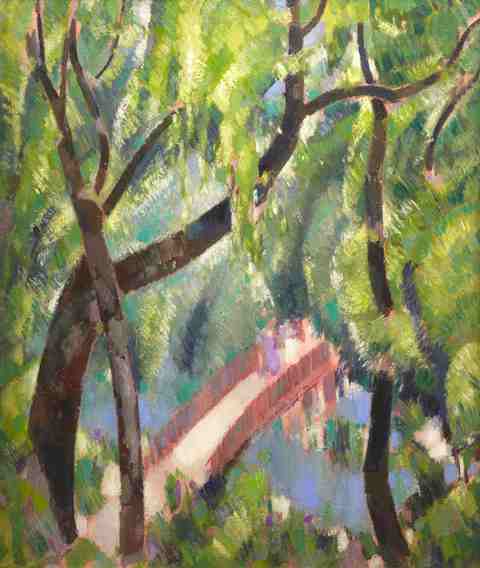
(Oil on canvas, 1942)
In 1939 with the outbreak of the Second World War the couple returned to Britain, setting up home in Glasgow, and Fergusson became actively involved with the New Scottish Art Group. This picture was painted near their flat on Clouston Street. The refracted light and rich, sonorous colour is similar to a late Monet with a softer touch.
J D Fergusson is regarded as the most versatile and experimental of the quartet of
Scottish painters known as the Colourists (along with Samuel Peploe, Francis Cadell
and Leslie Hunter). The work of the group remains highly influential to this day.
‘Everyone in Scotland should refuse to have anything to do with black or dirty and dingy colours, and insist on clean colours in everything. I remember when I was young any colour was considered a sign of vulgarity. Greys and blacks were the only colours for people of taste and refinement. Good pictures had to be black, grey, brown or drab. Well! let’s forget it, and insist on things in Scotland being of colour that makes for and associates itself with light, hopefulness, health and happiness.’
J.D.Fergusson in Modern Scottish Painting (pub. William MacLellan, Glasgow 1943)
This is a short film about J D Fergusson which was made to coincide with a major Scottish Colourist exhibition in Edinburgh 2013/14.
The University Art Collection has recently re-published a catalogue of these works with added accompanying essays. ‘Colour, Light, Freedom: Fergusson at Stirling’ can be purchased in the Pathfoot Building Crush Hall for £5, or ordered online here.
All images copyright The Fergusson Gallery, Perth